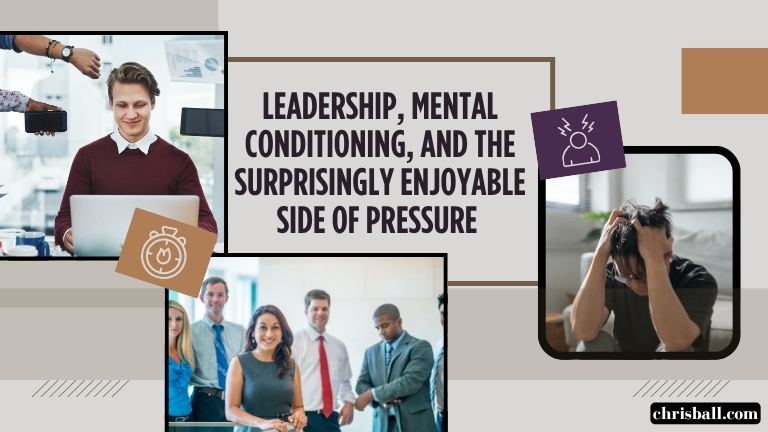Most people don’t think of leadership and fun in the same sentence. Unless it’s someone sarcastically muttering, “What fun,” while staring at a spreadsheet at 11pm. But what if leading well didn’t just mean performance and targets? What if it also meant enjoyment, ownership and sanity?
Let’s talk about mental conditioning. Not the military bootcamp version. Not motivational posters on the breakroom wall. Real, practical tools that help people deal with stress, stay focused, and actually enjoy what they do.
Sir Clive Woodward, the coach behind England’s World Cup-winning rugby team, knew this wasn’t fluff—it was foundational. He worked with sports psychologists to give players the tools to stay cool under pressure. He didn’t just want strong players. He wanted smart ones. Resilient ones. Players who could think clearly at 78 minutes into a match when their lungs were on fire and the game was on the line.
And here’s the interesting bit: he didn’t just hand them a playbook and tell them to try harder. He gave them ownership. He let them help shape their training. He made them think like decision-makers. The result? A team that didn’t just survive pressure—they thrived on it.
So what does that mean for you and your team?
You don’t need a locker room or a rugby pitch. What you need is a mindset shift. Most teams buckle not because they’re lazy, but because they’re overloaded, unclear, or simply don’t feel like they have any say. Add some pressure, and the wheels start to wobble.
Try this: the next time your team faces a challenge, don’t jump straight to giving instructions. Ask questions instead. “What do you think the best next step is?” “What’s standing in our way?” “What do we already know that could help?” You’ll be surprised how capable people are—once you let them take ownership.
Mental conditioning doesn’t require a psychology degree. It just requires a little structure. A few simple habits can shift a team from reactive to resilient.
Here are a few to try:
- Normalise pressure.
Not by brushing it off, but by calling it what it is. “This week will be busy. Let’s plan our energy, not just our tasks.” High-performing teams know pressure is part of the job, but they don’t pretend it’s easy. - Use short, focused resets.
Top athletes use visualisation, breathing, or quick routines to reset under pressure. Your team can too. Whether it’s five minutes of quiet time before a big meeting or taking a walk after a tough conversation, these small resets help people stay sharp. - Create autonomy without chaos.
Give people freedom to decide how they do their work—just be clear on the what and why. Ownership doesn’t mean “everyone just does their own thing.” It means “everyone knows what we’re aiming for and gets to help shape how we get there.” - Make learning normal.
Not just in training sessions, but in real time. After a win or a mistake, ask: “What worked?” “What would we do differently next time?” That reflection time builds the muscle of awareness, which feeds resilience. - Don’t just praise results—praise process.
Say someone handled a tricky situation calmly, or kept things moving when everything was falling apart. Highlight that. It tells your team that how they show up matters just as much as what they achieve.
One team I worked with introduced a “Resilience Round” in their weekly check-in. Everyone shared one moment from the week where they stayed calm under stress or solved a problem without drama. No false modesty allowed. Just real stories. It took ten minutes. But it changed the team dynamic. People felt seen—not just for finishing things, but for how they handled the tough bits.
Of course, none of this works if you’re walking around fried yourself.
That’s the kicker, isn’t it?
You can’t build mental fitness in your team if your own mental bandwidth is shot. So here’s your reminder: the team watches the leader. If you’re rushing, snappy, or stressed out, they’ll mirror that.
Take your own medicine. Block time to think. Ask for help. Reflect on what’s working. And if something keeps breaking, don’t just push harder. Step back and ask: what’s missing from this system? Is it clarity? Ownership? Energy?
The good news is, the moment you start treating mental resilience like part of the work—not an optional extra—you create a different kind of culture. One where people handle pressure without burning out. One where tough days don’t take people down with them. One where the process isn’t just survivable, but meaningful.
And dare I say it—sometimes even enjoyable.
If you’re curious about how this fits into the bigger picture, there’s a book I can recommend. It rhymes with Winning The Game (and it might just be called that). Inside, you’ll find practical ways to lead better, think sharper, and actually enjoy what you’re building—without needing to clone yourself or start drinking green smoothies at 5am.
Because leadership shouldn’t feel like dragging a sack of rocks uphill while smiling politely. It should feel like building something worthwhile, with people who grow as they go. And if that’s the game we’re playing, mental conditioning isn’t just part of it—it’s the key to actually winning.
